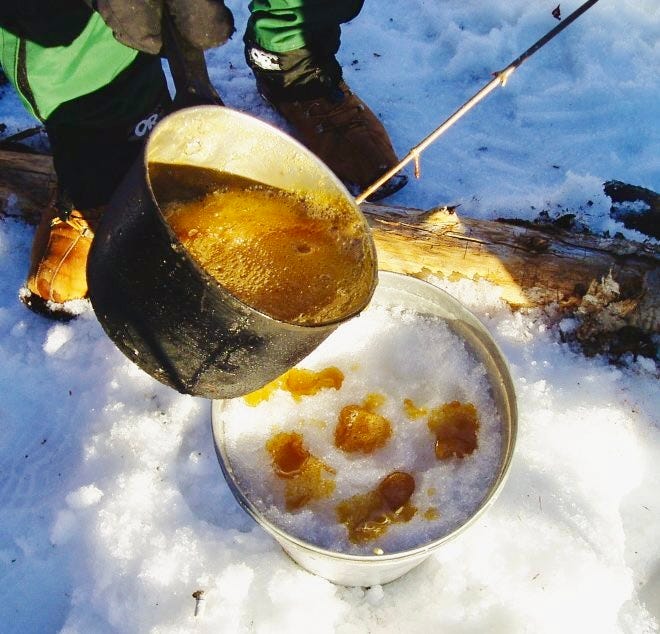Hello, friends.
When in Vancouver, do as Vancouverites do. Though part of the weekend was rainy, we didn’t let that stop us from going outdoors. I guess this is the secret to living in this rainy city—if the weather was to stop us from doing things in the winter, we’d be stuck indoors for months in misery, waiting for the sun to come back.
This weekend, we went out several times, including to a French-Canadian and Métis historical event called Vive Les Voyageurs Festival. The rain fell steadily all day, and we used our rain gear and big golf umbrella while tramping around the grounds. The festival was held at Fort Langley Historic Site, once a Hudson’s Bay Company trading post and built in 1827. The site is ringed by the buildings of the fort, including a blacksmith forge, and equipment such as a fur press, a lever-operated machine that compressed furs to be shipped to London.
(Hudson’s Bay Company, which now owns a bunch of retail companies like Saks Fifth Avenue, spent most of its existence as a fur trading business. It’s the oldest company in Canada, founded in 1670—about two hundred years older than Canada itself. Fun facts!)
Fort Langley was an important stop on the British Empire trading route, and saw robust trading with the local Indigenous communities starting in the late 18th century. Then came a gold rush in 1858, with 30,000 miners arriving to seek their fortunes. The British got nervous that the United States, sniffing riches, would come claiming this territory as their own, so the British quickly declared the land theirs and named it British Columbia. Thus was the colony established.
I love anything to do with the history of everyday lives, so this festival was my nerdy jam. We stopped and spent time at almost all the buildings at Fort Langley, interacting with the historical reenactors, who were excellent at giving us a flavor of working and living in those times.
We watched the blacksmith forging a Scottish kilt pin, which the fur traders repurposed for other uses like fastening bags. We saw a spoon and jig demonstration—playing the spoons, along with fiddle music, is a big part of Métis culture. And we participated in a French-Canadian folk music singalong about a lawyer who goes into a restaurant to eat a fish, chokes on the fishbones, and dies. It was not a subtle song, but it was fun.
After we finished looking through the buildings, we wanted to stop by the maple syrup candy stall near the exit, but it had closed. I think they didn’t have the traditional maple snow candy I wanted to try anyway. Otherwise known as maple taffy, it’s made by pouring hot maple syrup onto clean snow; once the maple syrup thickens and hardens, it’s lifted up with a wooden stick or something similar, and eaten like a popsicle. Yes, it is very Canadian.
Some highlights from Vive Les Voyageurs and the Fort Langley exhibitions:
Beaver pelts were used as money during the early days of trading. It hadn’t occurred to me that in these situations, even not so long ago, there was no established currency and so everything had to be bartered or pegged to a valuable object (in this case beaver pelts). Do you see the lines on the blanket in the photo at the top of this article? Blankets were marked in this way to indicate how many beaver pelts they were worth. Red was a sought-after color, so this blanket would have traded for five beaver pelts in its time.
The fur trapper gave a fascinating talk about traps commonly used for fur-bearing animals like beavers, muskrats, ermine, and even bears. Since fur was the goal, traps couldn’t have teeth or anything that would damage it. The designs trappers used were simple and clever, including the Figure 4 deadfall trap: trappers would make notches on sticks so the sticks could fit together in a figure 4 shape (see illustration below). They’d place a heavy object—like several branches lashed together or a big rock—on top of the figure 4, then bait the end of the horizontal stick under the heavy object. When the animal disturbed the bait, the whole contraption would come crashing down and pin it to the ground. With no harm to its beautiful fur coat.
This was during Victorian times, with Victorian work practices, which means there was a lot of child labor. Six-year-old children—with their small and nimble hands—were given the job of plucking the coarse, long guard hairs from beaver pelts. When they were done, the pelts would have only short, fine, soft hairs good for making clothing and hats. These children could do one pelt per hour, and they were paid two pennies a week for their hard work, enough to buy a couple of loaves of bread for the family.
I learned a bit about the Métis. Métis are a mixed race community rooted in the North American fur trade, formed when First Nations women and Euro-Canadian traders married. They, along with First Nations and Inuit, are recognized by the Canadian Constitution as Indigenous peoples. Métis have their own culture, language, and national anthem, distinct from First Nations or Europeans. They’re especially fascinating to me because I don’t know of any other mixed race groups in the world with such defined identities—are there others? Please comment if you know of any.
It was a good weekend. As we get to know local geography better, I feel more rooted. Being downtown, with the option to walk to many places, helps immensely. Fort Langley is far outside the city and we had to drive, but the next day we did walk to Chinatown for the Lunar New Year parade and celebrations. The long stroll allowed me to peek down alleys and in shop windows that usually blip by on my daily drives to Beanie’s school.
As I see parts of Vancouver up close, the city is feeling a bit more like home.
After we came back from Vive Les Voyageurs, as was her style, Beanie declared the visit “not fun.” But it should be noted that she nevertheless stood for 20 minutes without complaint at the beaver trapping talk, voluntarily watched a long video on Métis beading art, and when I had a question about what the blacksmith was making, she remembered and gave me the answer.
So despite her assessment of Not Fun, I hope the experience will nevertheless stick in her mind and kindle an interest in learning more about Canadian history, and history in general. That’s the goal of worldschooling, after all—not to simply observe one thing after another in different places, but to see in person the stories of the world, and engage more deeply with them. We’re lucky to have these opportunities, and I hope Beanie keeps reaping benefits from them far beyond this year.
Pretty Good Things
Métis culture

After our Fort Langley visit, I wanted to learn more about the Métis. I found a few short Youtube videos that were informative. Here is a general one on who the Métis people are.
And here is a video featuring Métis fiddle music.
Please tell me if you know of any good resources discussing the Métis, or especially well-written books and articles you’ve read about Indigenous peoples in North America. I’d like to know!








